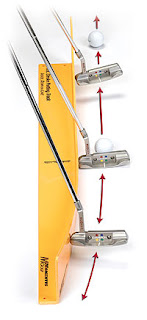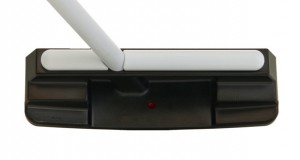During Wednesday’s practice round at the recent U.S. Open in Pebble Beach, PutterZone.com’s editor Sean Weir met Jim Sorenson (at left, with Fred Funk), founder of Momentus Golf, which specializes in golf training and fitness equipment. The company is perhaps best known for its Momentus Swing Trainer.
At Pebble Beach, Jim was on the practice green, where several professionals were using his Inside Down The Line Putting Track (pictured below). According to Sorenson, this trainer reinforces the type of stroke employed by Tiger Woods and other leading professionals. An accomplished golfer who played on the 1987 U.S. Walker Cup team, Sorenson spent five years on the mini tours before becoming a teaching professional. Soon thereafter, he developed the Momentus Swing Trainer, which is today used by more than 100 PGA Tour professionals and 500,000 golfers around the world, according to the company.
Following is PutterZone.com’s exclusive Insider Interview with Sorenson, focusing the Momentus Inside Down The Line Putting Track and revealing something new on the horizon: a Momentus putter.
When we spoke at Pebble Beach, you said that when a lot of professionals try your Inside Down The Line Putting Track, they say, “That’s my stroke.” What is that stroke—and why do so many professionals use it?
It’s a stroke that swings the putter slightly to the inside on the back stroke and then straight down the line on the through stroke. They use it because it is the most natural and effective method of putting. We have three of the top 10 players on the Champions Tour who are faithful Inside Down the Line putting stroke proponents: Tom Lehman, Tommy Armour III, and Larry Mize, who are respectively 5th, 9th and 10th on the money list.

What are your thoughts on the inside-to-inside arcing stroke and the straight-back-straight-through stroke?
The inside-to inside-stroke cuts across the ball through impact and imparts sidespin on the ball causing the ball to slice off to the right. The straight-back-to-straight-through stroke is unnatural, as the putter doesn’t sit vertically, but at an angle somewhere around 70 degrees where the golfer stands astride the ball, not like a pendulum of a grandfather clock where the shaft is vertical. Because of this, the putter must swing to the inside on the backstroke, not straight back.
Some putters are face balanced, while others have varying degrees of toe hang. What are your thoughts on putter balance as it relates to the type of stroke that your track aims to reinforce?
Physics is physics, and what makes a ball roll straight is about path and angle of contact, similar to hitting a golf shot. What makes a ball roll straight is an inside to down the line path with the putter, and whatever putter you can best make that stroke with is the putter for you. I don’t think face-balanced putters are the best to use because they eliminate the natural desire for the putter to have face rotation. Path and face rotation are the keys to making putts, and a face-balanced putter eliminates the natural face rotation of the putter.
What’s next from Momentus Golf on the putting front?
We have developed a new putter that conforms to the Rules of Golf for play. It is called the Inside Down the Line Putter. It is designed to work best with our Inside Down the Line Putting Tracks and features a 10-gram weight in the toe of the putter to slow down the rotation of the putter through impact.
 PutterZone – Best Putter Reviews
PutterZone – Best Putter Reviews





Lotsa weasel words and nothing resembling proof.
I think his concepts may be more-or-less correct, but he is selling a product that looks to find a middle ground between inside to inside and straight-back-to-straight-through. He could just as easily sell a straight-back-to-inside guide and if someone (like a pro) who practices two+ hours a day using it, it might just work.
What is never addressed by gurus and product sales people is what method will work best for the golfer who practices putting for 20 minutes a week (or less)? My guess would be the simplest to understand, and that is straight-back-to-straight-through.
As to putters: Putter designs promote stroke tendencies not absolutes. A face balanced putter does not "eliminate" "natural" face rotation, it reduces it, making a straight-back-to-straight-through stroke easier to accomplish. That same 70 degrees of lie is working here. Similarly, with little effort a toe heavy putter can go straight-back-to-straight-through. Once a golfer decides on a putting method, procurement of a putter that encourages that method is probably a bonus. However, a good golfer can putt reasonably well with pretty much any putter. Of course, we have our prejudices and we do love our toys.
Lotsa weasel words and nothing resembling proof.
I think his concepts may be more-or-less correct, but he is selling a product that looks to find a middle ground between inside to inside and straight-back-to-straight-through. He could just as easily sell a straight-back-to-inside guide and if someone (like a pro) who practices two+ hours a day using it, it might just work.
What is never addressed by gurus and product sales people is what method will work best for the golfer who practices putting for 20 minutes a week (or less)? My guess would be the simplest to understand, and that is straight-back-to-straight-through.
As to putters: Putter designs promote stroke tendencies not absolutes. A face balanced putter does not "eliminate" "natural" face rotation, it reduces it, making a straight-back-to-straight-through stroke easier to accomplish. That same 70 degrees of lie is working here. Similarly, with little effort a toe heavy putter can go straight-back-to-straight-through. Once a golfer decides on a putting method, procurement of a putter that encourages that method is probably a bonus. However, a good golfer can putt reasonably well with pretty much any putter. Of course, we have our prejudices and we do love our toys.